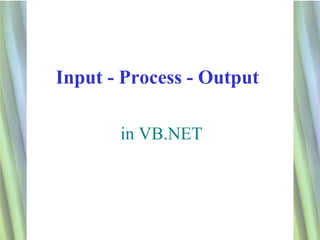
IPIO - Input, Process, Output in VB.NET
- 1. Input - Process - Output in VB.NET 1
- 2. Objectives Distinguish between logic and syntax Understand and use the input statement Understand and use the assignment statement Understand and use the output statement Understand and use arithmetic operators with precedence Successfully write program solutions that require input, processing, and output 2
- 3. Logic and Syntax A computer program is a solution to a problem. An algorithm is the logical design used to accomplish a specific objective. Syntax refers to the specific rules of a programming language. 3
- 4. Input Statements 4
- 5. Input Statements An input statement accepts data from the user and stores that data into a variable. A variable is a storage location that can be accessed and changed by developer code. A variable has a name and an associated data value. A variable has a data type that determines the kind of data values the variable can store. 5
- 6. Declaring Variables Variables are declared with the Dim statement (short for Dimension statement). One or more variables can be declared with a single Dim statement. The Dim statement can be used to specify the variable’s initial value by placing an equal sign after the data type. 6
- 7. Naming Rules for Variables A variable must have a unique name, called an identifier. Identifiers must follow three rules: Begin with a letter or underscore Contain only letters, digits, and underscores Cannot be reserved words Dim identifier [, identifier] [As datatype [= initialvalue]] 7
- 8. Working with Constants A constant is a storage location whose value cannot change during the execution of the program. Constants are declared with the Const declaration. Const identifier As datatype = value 8
- 9. Data Type Data Type Description String Text Byte (1 byte) Positive Whole Number (0 to 255) Short (2 bytes) Whole Number (-32,768 to 32,767) Integer (4 bytes) Whole Number (+ or – up to 2 million) Long (8 bytes) Whole Number (huge!) Single (4 bytes) Floating point (+ or – up to 3.4 x 1038) Double (8 bytes) Floating point (+ or – up to 1.8 x 10308) Decimal Stored exactly as BCD (currency & percentages) Date Also stores time Boolean True or false Char Single character or positive number (up to 65535) 9
- 10. Weekly Paycheck Program The weekly paycheck program has two input variables: Hours and Rate 10
- 11. Operators and Expressions An operator is a symbol that indicates an action to be performed. Value-returning code elements such as variables, constants, and expressions can be combined with one or more operators to form an expression. 11
- 12. Assignment Statements The assignment statement can be used to perform a calculation and store the result. An expression is a value-returning code element, such as a variable or mathematical formula. 12
- 13. The Assignment Statement An assignment statement is used to store a value into a variable or an object property. variable = expression object.property = expression The equal sign (=) is the assignment operator. 13
- 14. Numbers and String Operators Arithmetic operators require numeric operands and produce numeric results. The string operator concatenation (&) requires String operands and produces a String result such as: S = “sun” & “set” S becomes “sunset” 14
- 15. Numerical Operators Operation Operator Expression 1 Result 1 Expression 2 Result 2 Plus & + – 4–5+2 1 4 – (5 + 2) -3 Minus Multiply & * / 1+3*7 22 17 / 3 5.667 Divide Integer 12 4 3 17 3 5 Division Integer Mod 12 Mod 4 0 17 Mod 3 2 Remainder Exponent ^ 5^2+1 26 5 ^ (2 + 1) 125 (Power of) 15
- 16. How to Write Formulas 16
- 17. Output Statements (flow chart) 17
- 18. Intrinsic Functions VB .NET provides a large number of intrinsic functions to improve developer productivity. Intrinsic functions support a broad range of activities, including math calculations, business calculations, time and date functions, string formatting functions, and many more. 18
- 19. Common Functions Intrinsic functions are predefined commands that provide developers with common functions. Function Example 1 Result 1 Example 2 Result 2 Val() (“23.5”) 23.5 (“£32”) 0 IsNumeric() (“23.5”) True (“£32”) True FormatCurrency() (1234.567) £1,234.57 (4.5) £4.50 Format(expr,str) (1/2, “0.##”) “0.5” (6.666, “0.###”) “6.67” Int() (3.8) 3 Int(Rnd()) 0 Double value Integer Rnd() () Int(Rnd()*6)+1 between 0 and 1 from 1 to 6 Abs() (-3.3) 3.3 (5.67) 5.67 Import System.Math 19
- 20. Rnd Statement The Rnd statement generates a single precision random value between 0.0 up to (but not including) 1.0. The Randomize statement is used to change the seed value (random sequence). 20
- 21. Financial Functions Pmt is a function for determining monthly payments. Pmt(Rate, NPer, PV) FV is a function for determining the future value of an annuity based on periodic, fixed payments and a fixed interest rate. FV(Rate, NPer, Pmt) 21
- 22. Summary Variables are storage locations used for holding input and processing information. Each variable has two components: its name and its value. It is good practice to make variable names descriptive with mixed case. The Dim statement is used to declare a variable by specifying its name and data type. Input statements are used to get data into variables. Assignment statements are used to perform calculations and store the result. 22
- 23. Summary Expressions are combinations of operators and value-returning code elements such as variables, constants, and literals. One of the common uses of an expression is to perform a calculation for an assignment statement. Intrinsic functions provide pre-defined methods for common processing requirements. Output statements are used to display information. Input, assignment, and output statements are sufficient to write small programs. 23